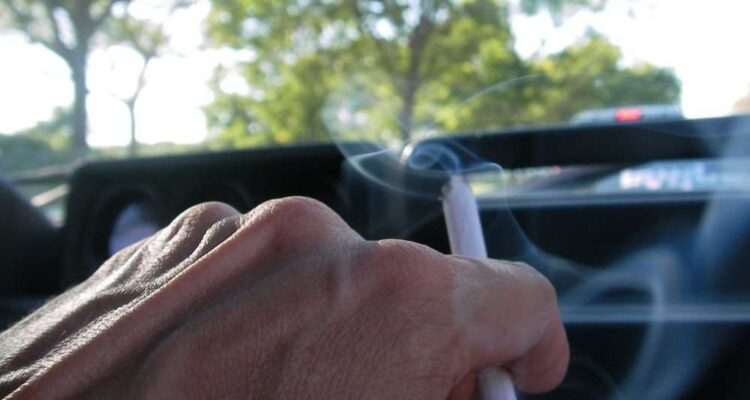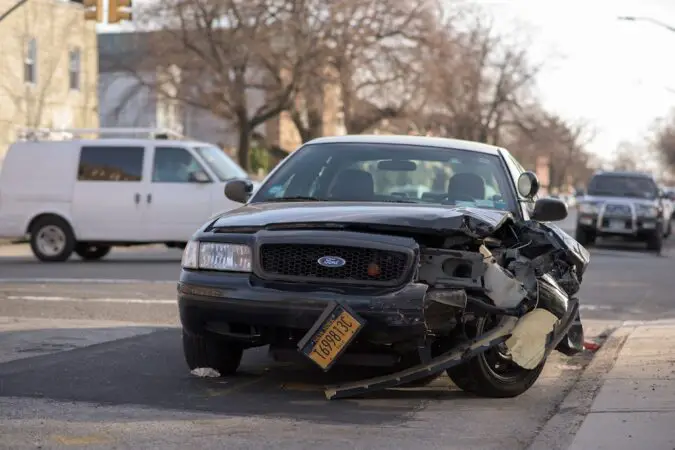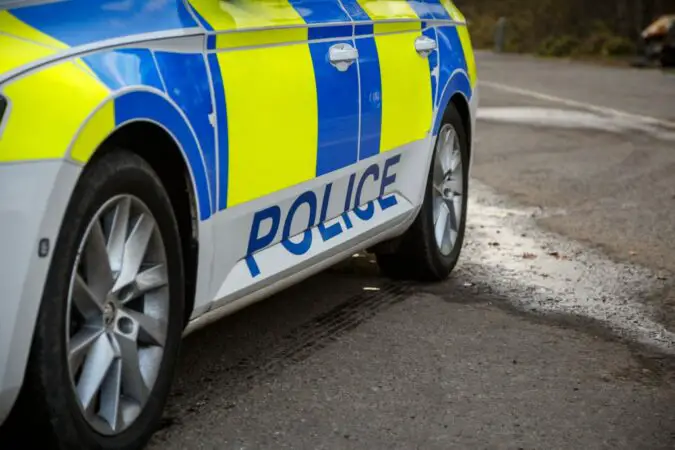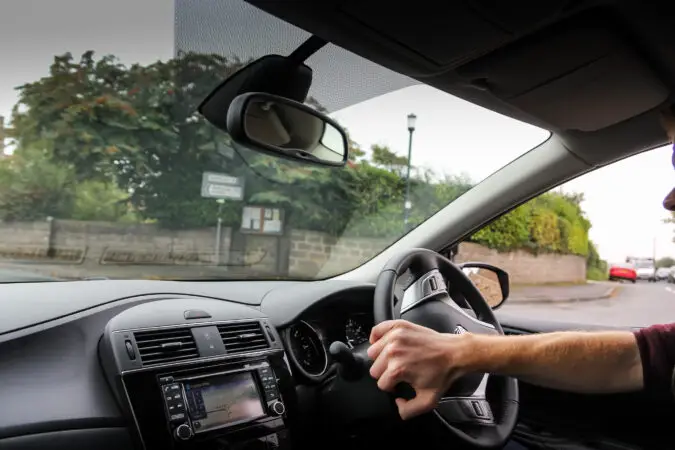People smoke for a variety of different reasons; anxiety, a force of habit, and recreational—depending on what you’re smoking. And I’ve been there. There have been times when I wanted to light up a cigarette while driving after a hard day. But can you smoke and drive?
The answer depends on what you’re smoking. Cigarettes or vapes? Perfectly legal, but there are a few things you need to know. Marijuana? Well, that’s the same as a DUI, and illegal in every state. If you’ve been wondering whether or not you can smoke and drive, here’s all you need to know:
- Cigarettes And Vapes
- Driving While High
- Safe Driving Tips
- Frequently Asked Questions (FAQs)
- Final Conclusion
Can You Smoke And Drive: Cigarettes And Vapes
Cigarettes, cigars, and vapes (or electronic cigarettes) are all perfectly legal to smoke while driving. Note that this doesn’t apply if your vape juice contains THC—as that’s the chemical in marijuana that makes you high.
However, there are several actions related to smoking that can get you in trouble. This includes:
- Smoking with a minor inside the car.
- Tossing cigarette butts out the window (littering).
- Distracted driving due to lighting up a cigarette or smoke obstructing the windshield can get you in trouble.
View this post on Instagram
So, make sure no minors are in the car and you have an ashtray in the car to put your cigarette out. Doing one or more of the things above can get you in trouble with the law.
One more thing to note, insurance companies may charge you a higher premium if you’re a smoker. In the eyes of insurance companies, smokers are more likely to drive distracted and have a higher risk of being involved in an accident. Hence the higher insurance premium.
States Banning Smoking With Minors
We should remind you that the health effects of inhaling secondhand smoke are very dangerous. And some research even suggests it’s more dangerous than smoking the cigarette itself.
So, regardless of whether your state bans it or not, you really shouldn’t smoke while there’s a minor with you. Personally, I have a rule that I won’t smoke in a confined space with a non-smoker. In any case, these states make it illegal for you to smoke with a minor in the car:
- Arkansas.
- California.
- Illinois.
- Louisiana.
- Maine.
- Oregon.
- Utah.
- Vermont.
- Virginia.
Guam, Northern Mariana Island, and Puerto Rico also ban smoking with a minor in the car. They’re not a US state, but they are US territory.
Again, you shouldn’t smoke with a minor in the car regardless of state laws. But if you do so in the states above, it’s going to be a petty offense with a fine of up to $100 for a first offense and up to $250 for a repeat offense.
Doesn’t sound too bad, but mind you, Child Protective Services (CPS) may get involved. How about vaping with a minor in the car? As far as we can tell, there are currently no laws prohibiting this. However, we’re not legal experts, and you should avoid this as well.
Fines For Littering
As mentioned, throwing your cigarette butts out of the car can get you in trouble. Sure, most of the time you can probably get away with this. But if Johnny Law’s feeling like it, then they’ll probably pull you over just for this.
Every state has some sort of littering law, and throwing cigarettes out of your car window is punishable by a civil penalty. Fines usually range between $100 and $500. Additionally, you may need to serve eight (8) hours of community service.
Driving While High
Driving while high is completely illegal, full stop. While smoking marijuana affects your motor skills differently than alcohol, it still does that: affecting your motor skills. So, you’re essentially driving while under the influence (DUI).
For the sake of your—and everyone else’s—safety please do not drive while you’re high. Here’s more if you want to know about driving while high:
Driving While High Consequences
As mentioned, being high affects your motor skills and impairs your judgment. This means the risks are essentially the same as drinking and driving. But if you need a reminder, here are the risks:
- Similar to drunk driving, you’re more likely to crash by about 1 or 3 times more than sober drivers. Much like drinking, this depends on the level of THC you have in your system. But it’s all the same: you’re more likely to be involved in an accident.
- License suspension of 90 days to a year, and fines ranging from $500 to $2,000. This depends on the prior offenses and the state you live in.
- Court-mandated substance abuse treatment.
There is no roadside test for testing THC levels, unlike drinking where officials can do a breathalyzer test. But please, don’t think you can get away with it.
Admittedly, there is federal data that suggests driving while high is less risky than drinking and driving. But you’re still at increased risk, so why do it? Just because you’re less likely to lose an arm when fighting a shark than a crocodile doesn’t mean you should fight the shark.
Driving High vs Driving Drunk
Again, neither is better. Some people may feel like they have better judgment and motor skills while high than drunk, you really shouldn’t drive while you’re under any sort of influence.
Take one story published by VICE, where a 23-year-old IT engineer had a marijuana-related accident. He stated that he was driving high in heavy traffic. And the time dilation made it feel like he’s been there for hours.
He then decided to shut his eyes while waiting for traffic. His car, which was an automatic, crept forward while he nodded off. And he ended up crashing into the car in front of him.
The bottom line is that driving while high still increases your chances of getting into an accident, albeit less likely according to some studies. It’s best that you don’t do it, and be a safe and sober driver.
How Long Should You Wait?
If you’ve been smoking marijuana and you need or want to drive, then you should wait. This depends on the THC level you have in your blood:
- At least six (6) hours after smoking marijuana that contains less than 35mg of THC. Any more than that, you should wait for at least eight (8) hours.
- At least eight (8) hours after eating or drinking marijuana with less than 18mg of THC.
Edible cannabis takes longer to kick in. But your liver converts THC into a stronger form and has a more powerful effect. Hence why you need to wait longer.
Most people probably don’t measure how much THC they have in their marijuana unless they’re vaping it. And since we like to be on the safe side, please wait at least six hours before driving if you’re high. Or maybe call an Uber?
Driving While High Charges
Let’s discuss the charges if you were to drive while high. As mentioned, driving while high will land you a DUI. Prosecutors will need to show evidence of poor field sobriety test (FST) performance, slurred speech, unusual behavior, and/or bad driving.
If they suspect marijuana is involved, the prosecutor will produce a blood test to see the THC level in your blood. State laws vary on how much the legal limit is, but it’s generally between 1 to 5 ng/ml of THC. For context, 15 minutes of smoking will have your THC level reach around 100 ng/ml.
We’ve already mentioned the charges, such as license suspension, fines, and substance abuse treatment. You may do up to a year of jail time as well, although most offenders don’t do substantial jail time.
If you’ve had criminal records, especially serious ones such as a DUI that involves injuries or deaths, the prosecutor will not be as lenient. You’re looking at some serious jail time.
To further discourage you, note that THC stays for 36 hours in your blood and up to a month in urine. So, even if you don’t smoke much before you drive, the blood test may show a high THC level and will likely get you in trouble. Bottom line: best to not mess around and stay sober while you drive.
Can You Smoke And Drive: Safe Driving Tips
So, we’ve established that smoking cigarettes while driving is legal for the most part. And smoking marijuana—while less dangerous—is illegal in every state. Best to stay sober while driving and be a safe driver.
Speaking of which, here are our tips on how to become a safer driver:
Can You Smoke And Drive, Safe Driving Tips #1. Buckle Up
You’d be surprised to find out how many people don’t see the importance of putting on your seatbelts before you drive. Most of the argument is about how it limits their movement while driving and is uncomfortable.
As uncomfortable as it may be, it’ll be more uncomfortable when you get thrown out through your windshield because no seatbelts are holding you.
Most cars nowadays come with a warning system that beeps loudly if you don’t put the seatbelts on while driving. The second-generation MINI Cooper will beep even before you turn on the car. Anyway, please put on your seatbelts. It will literally save your life.
Can You Smoke And Drive, Safe Driving Tips #2. Keep Your Distance & Defensive Driving
Regardless of how good your brakes are, cars will need time and distance to come to a complete stop. So, always keep your distance when driving behind somebody.
A safe distance is about 300 feet in most cases is 300 feet. But keeping a 500 feet distance is a good idea when you’re going at highway speeds. If someone’s getting a little too close for comfort behind you, give way to them so you’ll avoid being rear-ended.
As for defensive driving, this is a somewhat broad term. But it generally means that you take precautions to avoid accidents and incidents on the road.
This includes being fully aware of your surroundings, giving way and not rushing in an intersection, staying calm to avoid road rage, and of course, keeping a safe distance.
Can You Smoke And Drive, Safe Driving Tips #3. Keep Up With Maintenance
On top of regular oil changes, you need to keep up with maintenance for tires, brakes, and suspension components. These are crucial for your driving safety, and if they’re in less than optimal condition, can increase your chance of an accident.
For example, tires with thin treads will have less traction on the road. This will increase your stopping distance—especially in wet conditions—and could mean your car may not stop in time in the case of an emergency. Even when you’ve kept a safe distance.
Here’s what you need to do:
- Most tires last for about two to three years. Check your tires’ tread depth with a tread depth gauge at least once a year. If it’s less than 2/32 inches, you should replace your tires.
- Rotate your tires every 6,000 to 8,000 miles. This ensures even tread wear, helping your tires to last longer and improving safety while driving.
- Wheel alignment is the process of aligning various wheel angles to make sure your car drives straight and true. Misaligned wheels can affect handling performance, and increases the chance of an accident. The frequency depends on how much you drive, and you can learn more here.
- Service your brakes, most importantly is changing your brake pads when necessary. Neglecting your brakes will increase the stopping distance, putting you in danger.
- Pay attention to weird noises (such as a weird noise in the engine bay). Grinding, whining, squeaking, and knocking noises are a sign that something’s broken or worn out and can affect your safety.
There are many more maintenances that you should keep up with to ensure your safety while driving, such as making sure you have the correct tire pressure (just like the Telsa Model 3 tire pressure). Watch the video above to learn more.
Can You Smoke And Drive, Safe Driving Tips #4. Can You Smoke And Drive: Don’t Drive Distracted
In addition to driving while high or drunk, keep distractions to a minimum while driving. Most importantly: don’t play with your phone while you drive.
We get it, sometimes the drama on Twitter is just too good to miss. But a 2018 study by the AAA Foundation found that playing on your phone while driving increases the chance of a fatal risk by 66 percent.
So, best to put your phone away in the glove box when you’re driving. Or make use of features like Bluetooth and Apple CarPlay so you can still answer those important phone calls.
If you need to use your phone, light up a cigarette, or do anything else that may distract you while driving, it’s best to pull over first. Find a safe space to do whatever it is, then continue driving once you’re no longer distracted.
Can You Smoke And Drive, Safe Driving Tips #5. Be Prepared
Sometimes accidents or breakdowns are unavoidable. If you do have an incident, it’s good to be prepared so you can deal with the situation. Here are the things we recommend that you have in your car:
- Jumper cables for when your battery dies and you need to jump the car to get it home or to a repair shop (but first, make sure you know how to connect jumper cables).
- Fire extinguisher. In case of fire, having a fire extinguisher will help you, well, extinguish the fire and hopefully minimize the damage.
- First-aid kit. Much like the fire extinguisher, hopefully, you’ll never need to use this. But in the event of an accident, having a first-aid kit means you can treat wounds yourself.
- Power bank. You never know when and where you might break down; it could be the middle of nowhere and your phone is dying and can’t call for help. And your car may lose all power and not be able to charge your phone.
- Tire change kit and a spare tire. Having these and knowing how to change a flat tire yourself means you won’t have to wait for help just to change a flat. If you don’t want the hassle, consider using run-flat tires—although they have their limitations and drawbacks.
There are many more tools you can have in your car, but we think the ones we mentioned above are the most necessary and will help you in an incident. Watch the video above for more recommended things to have in your car.
One last note, don’t keep the power bank in your car as the cabin will get hot and that’s dangerous. Best to keep it in the bag with you, and take it out when you need it.
Can You Smoke And Drive, Safe Driving Tips #6. Adjust Mirrors Properly
Before you even start your car, take a moment to adjust your side and rearview mirrors. Properly positioned mirrors help in minimizing blind spots, allowing you to be more aware of your surroundings. When you adjust, ensure you see as little of your car as possible and maximize the view of the road behind. Every time someone else uses your car or if you feel they’ve been bumped, recheck their positioning.
Can You Smoke And Drive, Safe Driving Tips #7. Be Wary of Weather Conditions
Rain, snow, and fog all reduce visibility and can make roads slippery. Before heading out, always check the weather. If conditions are particularly bad, consider postponing your trip. Otherwise, increase the following distance, reduce your speed, and use headlights even in daylight to increase visibility. When driving in wet conditions, avoid standing water on roads, as this can lead to hydroplaning.
Can You Smoke And Drive, Safe Driving Tips #8. Avoid Night Driving If Possible
While there may be less traffic at night, hazards can be magnified due to decreased visibility and the glare of oncoming lights. If you must drive at night, make sure your headlights and taillights are working correctly. Also, reduce speed and increase the distance from the vehicle ahead to give yourself more time to react.
Can You Smoke And Drive, Safe Driving Tips #9. Always Use Indicators
Your turn signals aren’t just for show. They’re an essential tool for communicating your intentions to other drivers. Always indicate well in advance before you turn or change lanes. Moreover, be sure to turn off the signal after you’ve completed the maneuver.
Can You Smoke And Drive, Safe Driving Tips #10. Avoid Aggressive Drivers
On the road, you might encounter drivers with aggressive or erratic behaviors. Instead of engaging or competing with them, maintain a safe distance. If someone is tailgating you, switch lanes when it’s safe and let them pass. Remember, safety first.
Can You Smoke And Drive, Safe Driving Tips #11. Be Mindful of Pedestrians and Bikers
Especially in urban areas, always be on the lookout for pedestrians and bikers. Yield the right-of-way at crosswalks and be especially vigilant in school zones or neighborhoods where children might be playing.
Can You Smoke And Drive, Safe Driving Tips #12. Never Drive Under the Influence
Alcohol, drugs (including prescription medication), and driving never mix. Even a small amount can impair your judgment and reflexes. If you plan to drink or are under medication, designate a sober driver or use public transportation.
Can You Smoke And Drive, Safe Driving Tips #13. Get Enough Rest Before Driving
Drowsy driving can be as dangerous as drunk driving. Fatigue slows down your reaction time, impairs judgment, and can even lead to microsleeps—brief moments where you actually fall asleep behind the wheel. Always ensure you’re well-rested before embarking on a journey, and during long trips, plan regular breaks to rest and stretch.
Can You Smoke And Drive, Safe Driving Tips #14. Keep an Emergency Kit
Beyond the mentioned essentials, consider keeping an emergency kit that includes non-perishable food, water, blankets, a flashlight with extra batteries, and basic tools. This becomes especially crucial during winter months or if you’re traveling through remote areas.
Can You Smoke And Drive, Safe Driving Tips #15. Know Your Car’s Limits
Each car behaves differently, especially under duress. Know what your car is capable of, its turning radius, and stopping distance. Regularly test brakes, especially if you’re in a new or rented vehicle, to familiarize yourself with their responsiveness.
Prioritize safety above everything else on the road. Following these guidelines not only ensures your safety but also contributes to a safer environment for everyone on the road.
Can You Smoke And Drive: Frequently Asked Questions (FAQs)
Got any more questions about driving and smoking? Here are some commonly asked questions and the answers you might find helpful:
How Does Road Rage Affect Your Driving Skills And Judgment
Road rage puts you in a state of adrenaline rush and raises your heart rate. This also makes your survival instincts kick in, and will impair your judgment. You’re more likely to engage in erratic actions, increasing the chance of an accident. Avoid driving while you’re emotional, and give yourself time to get to your destination. Being in a rush makes you impatient and increases your chance of experiencing road rage.
Can You Drive While High
You can’t, driving while high will land you a DUI charge if you get caught. Fines may be as high as $2,000, and you risk a court-mandated substance abuse treatment.
Is Smoking Worse Than Drinking
Smoking is generally worse than drinking. Certain types of alcoholic drinks can have very minor health benefits in moderation. Whereas there are no benefits to smoking and it has a long list of adverse health effects.
Can You Smoke Anywhere In Colorado
The Colorado Clean Air Act prohibits you from smoking in most public indoor places. Marijuana smoking or any other kind of consumption is NOT permitted in public spaces except at a licensed marijuana retail or hospitality business.
Is It Illegal To Smoke In A Car With A Child
There are currently nine states where it’s illegal to smoke in a car with a minor, which are Arkansas, California, Illinois, Louisiana, Maine, Oregon, Utah, Vermont, and Virginia. Guam, Northern Mariana Islands, and Puerto Rico are US territories that also prohibit this. Additionally, check your local laws as some states may be testing a new law that prohibits this. In any case, it’s very dangerous for your child to inhale secondhand smoke and we recommend you don’t do this regardless of where you are. Child Protective Services may get involved.
Can I Drive After One Beer
One drink per hour helps you to avoid having a blood alcohol content of 0.08 percent—which is the limit for a DUI. So, it’s generally safe to drive after consuming one beer if you wait an hour. However, alcohol affects everyone differently; women and individuals with less weight may have lower resistance and are affected more than others. Bottom line: wait at least one hour before driving to be on the safe side.
Can You Smoke In Your Car With A Medical Card
The National Conference of State Legislatures or NCSL for short states you can’t and doing this will likely land you a DUI charge. You can legally smoke it if you’re a passenger, but not as a driver.
Is It Safe To Drive High
While there have been studies that suggest driving while high is safer than drunk driving, it’s still dangerous. Being high impairs your judgment and motor skills, both of which are crucial when driving. There have been many stories of drivers getting into an accident while driving high, and you shouldn’t risk it.
Can You Smoke And Drive: In Conclusion…
So, can you smoke and drive? In conclusion, you can legally smoke cigarettes, cigars, or vapes while driving. As long as you don’t throw your cigarette butts out the window, and you don’t smoke with a minor in certain states, it’s perfectly legal to do so.
Again, we remind you to not smoke with a child regardless of what state you live in. Secondhand smoke from cigarettes poses a very real danger, and you shouldn’t smoke in a confined space with them if you care about them at all.
As for marijuana, while it’s now mostly legal, there are still a few laws and regulations you should be aware of. Smoking them and driving is still illegal, regardless of whether you have a medical card or not. Doing so will likely land you a DUI charge.
Additionally, many states—such as Colorado—still ban smoking or other methods of consumption of marijuana in public places. If you’re not sure about your local laws, best to do it at home. Or at a licensed marijuana dispensary.
Hopefully, this has been a helpful article for you. Use marijuana safely and responsibly, and stay safe—and sober—while driving!










